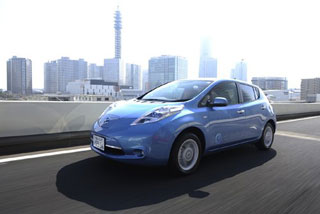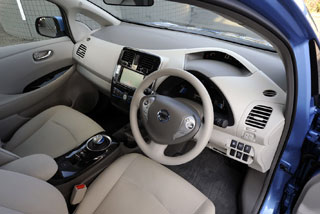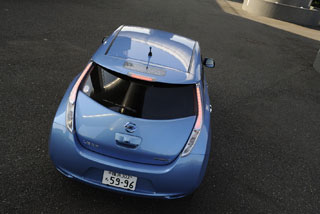Test Drive Nissan Leaf since 2010 Hatchback
Test drive of the newest electric car Nissan Leaf
 Driving a new electric vehicle
Driving a new electric vehicle Immediately I want to say that the electric vehicles are uncomfortable. Even if you manage to find charging item, the process will take 20 minutes at best.
When I drove the electric vehicle Nissan Leaf drove into the territory of the Ebin Service station, was already noon. My car, as well as serving personnel, was needed a lunch break: out of ten white divisions displaying the battery level, only two were burning.
When I only started the car, the display displayed the maximum possible distance of 127 km (140 km in eco-friendly mode), this indicator now dropped to 60 km. The distance, in principle, is considerable, but since I was completely unfamiliar with the car, I decided not to experience the fate and to make a freight as soon as possible.
By the way, the distance that this electric vehicle can be covered with a fully charged battery, depending on the measurement method in different countries is determined in different ways: so, in Japan, this figure is 200 km, 160 km in Europe, in Europe is 175 km.
While I drove in the crowded city, no one paid almost no attention to my car, but it was worth it to open the lid in the car's nose and stretching a thick cable from a quick charger to the charging port of the above-mentioned station around the car instantly gathered a crowd. And this is understandable: during the crisis period, more and more people are interested in electric vehicles, which, according to rumors, are more economical than gasoline. And how much is it worth?, Asked someone from the crowd.
Fast charger charges a car for 20-30 minutes; The cost of charging may differ depending on the charger, but given the government subsidies on electric vehicles, which entered into force in 2010, the amount, as a rule, does not exceed 100 yen (about $ 1,3); For a complete charge of an empty battery from a home power grid, 8 hours will be required; The machine costs 3,764 250 yen (about $ 50 190), but thanks to government subsidies, the cost decreased by 780,000 yen (about $ 10,400) and now it is 2,984,250 yen (about $ 39,790) I answered questions curious while the car was charged.
 Free charging
Free charging After about 20 minutes, the battery charged by 80%, and a distance of 127 km was displayed on the display from this value I started my test drive.
What is interesting, on the check, which was submitted to me for the payment, was the amount of 770 yen (about $ 10), and below was Poster -770 yen, that is, actually the service provided me completely free. Many stations across the country are already beginning to develop their own charges of charging electric vehicles, since the development of this kind of transport is inevitable.
Many drivers would prefer the electromotive to be serviced as familiar and easily, like gasoline cars. For many, in addition to location, refueling is an important point of payment. On quick chargers, you can pay as a card and cash.
Electric vehicles can boast an excellent weight distribution, as they do not have a really heavy internal combustion engine, and the battery is located in the center. It affects manageability and, accordingly, at the level of sales. With increasing revolutions, good torque develops, and the car accelerates surprisingly smoothly.
Throughout the history of the development of electric vehicles, many drivers, for the first time, behind the wheel of such a car were experienced real enthusiasm, but they did not receive a truly widespread electromotive, since in many respects there were still losing cars with MAKS. In addition, there was no relevant infrastructure for their normal functioning.
On motorway
The sizes of its 5-door body Nissan Leaf exceeds its fellow on the Tiida workshop. The car is designed for five adults, a fairly large trunk is able to accommodate 2 golf bags. The mass of the car is 1520 kg, in motion it leads the motor with a maximum torque of 28.6 kg-m. The machine starts not worse than the Nissan Fuga equipped with a 2.5-liter engine.
During numerous turns on the winding motorway, I had an amazing and familiar feeling that the center of gravity passes through my spine. Something similar I have experienced at the wheel of the first generation of the Toyota Estima.
The ratio of the weight of the front of the car to the back is 57:43. This indicator was achieved due to the fact that the lithium-ion battery is located under the floor between the axes, and the mass of the electric motor, which is in the front of the machine, is 2/3 of the mass of the usual engine. The car has excellent handling and accurate reaction to the steering wheel, and when the driver's back turns, the driver is slightly pressing towards the seat back.
 The soundproofing of the car is not inferior to Nissan Fuga, but wind noise and tires, which in ordinary cars dries the sound of the engine, here is heard much more distinct. As for the comfort of a ride, if the car went smoothly in the city smoothly and smoothly, on the motorway, eco-friendly tires seemed to me too hard. Each irregularity on the roadbed was transferred to the salon with tangible jogs.
The soundproofing of the car is not inferior to Nissan Fuga, but wind noise and tires, which in ordinary cars dries the sound of the engine, here is heard much more distinct. As for the comfort of a ride, if the car went smoothly in the city smoothly and smoothly, on the motorway, eco-friendly tires seemed to me too hard. Each irregularity on the roadbed was transferred to the salon with tangible jogs. When I rebuilt on a more high-speed series of highway, the number that displays the remaining kilometers, the beginning began to shrink rapidly. It served me a kind of warning back to the cost-effective driving regime and the corresponding speed.
New Horizons
The driver's seat is designed in such a way that the owner of the car felt behind the wheel as convenient as possible and comfortable. On the steering wheel there is a button that allows you to display the battery charge level on the navigation system. And by clicking on the Zero Emission button on the central console, you can get data on the location of the nearest charge items and other useful information for the owner of the electric vehicle.
In the past, many companies have repeatedly proclaimed the occurrence of the era of electric vehicles, but in the practice of the car on the battery did not receive special distribution. This time, the engineers from Nissan tried to take into account all the modern trends and embody them in Leaf. Now that the charge of the battery is approaching the zero mark, the owner does not have to bother the search for the nearest charge item for it will make a smart computer system. The developers hope that these innovations will allow the new Leaf to achieve greater popularity than its less successful predecessors.
 2 200 Nissan dealerships all over the country installed on the territory of their auto centerrs of a regular charging device (200V), while the number of fast chargers near the stores and eaters already reaches 200. As written in the LEAF catalog, rapid charge points are scattered throughout Japan. So that the driver, in whatever point of the country he was, could at any time find a charger within 40 km. Now the owner of the electric vehicle can safely go to an arbitrarily distant trip. Nevertheless, during my test drive, at many paragraphs charging was a day off, and I could not charge there.
2 200 Nissan dealerships all over the country installed on the territory of their auto centerrs of a regular charging device (200V), while the number of fast chargers near the stores and eaters already reaches 200. As written in the LEAF catalog, rapid charge points are scattered throughout Japan. So that the driver, in whatever point of the country he was, could at any time find a charger within 40 km. Now the owner of the electric vehicle can safely go to an arbitrarily distant trip. Nevertheless, during my test drive, at many paragraphs charging was a day off, and I could not charge there. The specifics of the electric vehicles are such that without recharging far on it will not leave. The owner of a similar car is to a certain extent depends on the charge items and is forced based on this to calculate its time. Nevertheless, Leaf will probably have a lot of fans. The car does not spend energy at idle, and the maximum speed when driving in economy mode is 50 km / h, so it can be safely bold as an extra machine for the city.
During long-distance drives on the electric car, you should be ready for the need to be able to charge in unfamiliar points, and your own power mode is constantly coordinated with the machine power mode. Well, this is now the fee for environmental friendliness.
Specifications Nissan Leaf
Total Length: 4445 mm
Total width: 1770 mm
Total height: 1545 mm
Wheel base: 2700 mm
Mass: 1520 kg
Drive: Front
Engine: electric
Maximum output power: 109 hp at 2,730-9 800 rpm
Maximum torque: 28.6 kg-M at 0-2730 rpm
Maximum full charge distance: 200 km (in JC08 mode)
Cost: 4,060,350 yen (about $ 54 140)
The cost of the test model: 4 135 950 yen (about $ 55 140)
Options: Exclusive Painting (Aqua Blue) 42 000 yen (about $ 560), special equipment for cold regions 33 600 yen (about $ 450)




A source: webCG.net











